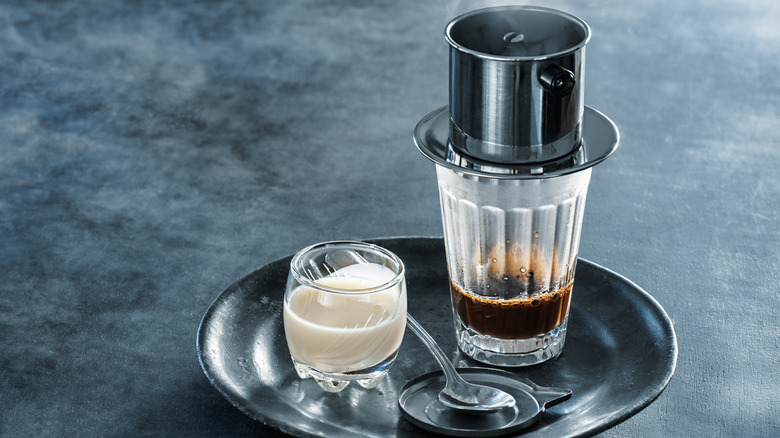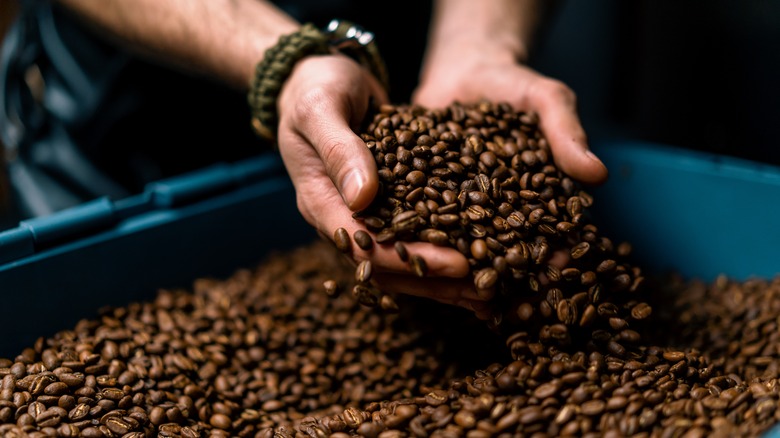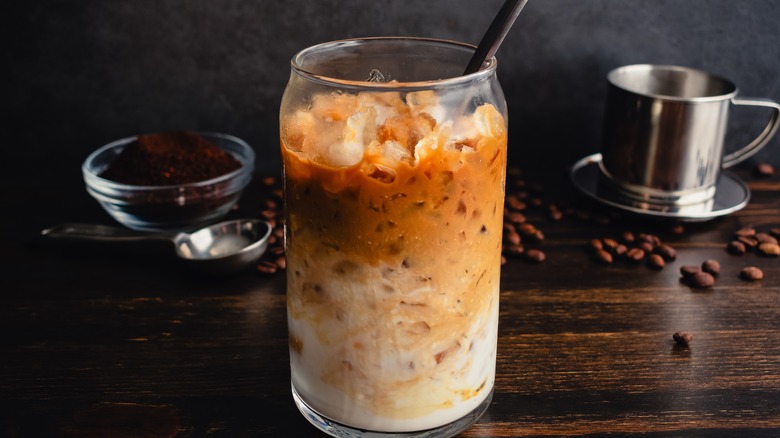The Best Vietnamese Coffee Starts With This Type Of Beans
Vietnamese coffee is a delicious cousin of a caffe latte made with sweetened condensed milk — which delivers both dairy and sugar in a single ingredient — and prepared with a phin filter. This contraption is similar to a pour over system, except that it's a slightly slower process and uses less water, making for a stronger, more viscous finished product. This drink is also delicious served with ice as the caffeinated antidote to a hot day.
You can prepare any type of coffee according to this process, but if you've ever tried Vietnamese coffee with your usual beans and thought it was too sweet, it could be because yours are quite different from the kind for which the drink was developed. To ensure your Vietnamese coffee is the best version you can possibly make, it's essential to start with the beans themselves. In this case, it's the inherent qualities of the Vietnamese Robusta beans that keep this drink in balance.
Why these beans are best
Sometimes it's helpful to look at the origins of a culinary preparation to understand how it developed and why it works. In Central Vietnam, the highland area in which the Robusta variety of coffee grows is also home to other globally beloved products, cacao and pepper among them. There, in the basalt soil, this type of bean develops its signature flavors, which can include roasty or woody notes and those reminiscent of chocolate, leaning almost into mocha territory. During the roasting process, a type of fat — in the form of oil or butter — may be added, which contributes to this coffee's unique profile. The resulting Robusta brew is medium to dark roast, bold and assertive, and a bit bitter. These beans would make a pretty intense cup of black coffee, so it makes sense that a sweet and creamy addition would be employed as a counterpoint to help temper and soften the flavor.
If you've dipped a toe into the beginner's guide to the wide world of coffee, you may already have an idea of the differences between Robusta and Arabica beans, but it's important to note for this purpose that there are multiple types of Vietnamese coffees. Robusta beans are considerably higher in caffeine than Arabica (a variety that is likely more familiar to the American consumer), which means that serving Vietnamese coffee with ice also dilutes the strength and tames the bitterness.
Alternative ways to brew your Vietnamese coffee
In today's specialty coffee landscape, you can source Vietnamese Robusta from several companies, including Nguyen Coffee Supply and Blue Bottle. If you can't get your hands on these particular beans, however, you can seek out an option with similar qualities. Speaking with the barista or roaster at your local coffee supplier is a great place to start for guidance as they can likely recommend something well-suited to this preparation, but if you need to make a selection on your own, reach for a bold medium to dark roast that's lower in acidity.
When it's time to prepare, if you don't have a phin filter, there are other methods that will yield acceptable results. A French press delivers coffee with a similarly full body. A concentrated cup from an espresso machine or even a stove-top moka pot will also come close to these powerful brews and pair well with condensed milk.
When it comes to mixing in your creamy element though, you can also opt for a nondairy option like coconut milk, which will give the drink a slightly different flavor that still complements these bold beans. If you want a really refreshing treat, you can even make delicious frozen Vietnamese coffee with just three ingredients, or go for a richer variation made with egg yolks in addition to sweetened condensed milk. By starting with these Vietnamese beans, you have the beginnings of a very delicious beverage, no matter what.


